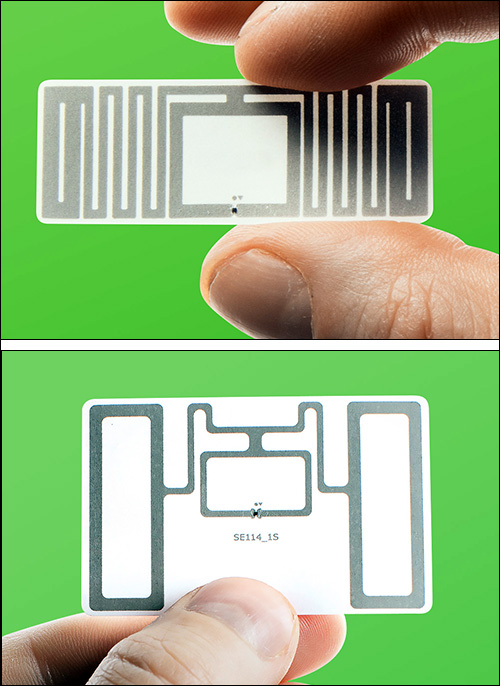Paper and forest products company Stora Enso, located in Helsinki, Finland, is venturing further into RFID technology as part of its intelligent packaging paper and pulp-based solutions, with a portfolio of ECO paper-based tags that are aimed at retailers. The new recyclable labels are being sold for use by brands and retailers in hangtags and price labels. The five new products, available in label format, include the ECO Hanger, Hanger S, Hook, Hook S and Rack; each is designed to be recyclable and to use fewer materials than standard RFID labels.
The first ECO tag was released in November 2018 to enhance the company’s intelligent packaging products, according to Juha Maijala, Stora Enso’s deputy head of intelligent packaging. The UHF RFID technology results from several years’ efforts to build a more environmentally friendly RFID tag that utilizes paper rather than plastic. “We have been working around RFID for 15 years,” he says, adding that his firm has provided intelligent packaging solutions that enable brands and retailers to uniquely identify and track packaged goods.
Two years ago, Stora Enso opted to begin developing its own tags that could be built into that packaging. Now it is selling the tags as ECO labels for use by brands and retailers, to help them meet customers’ demands for sustainability. “We are new entrants to the RFID tag business,” Maijala says, “so we’re taking a step-by-step approach.” To that end, the firm sells the tags directly to service bureaus, which then create the RFID-enabled price label with those ECO tags for the brands.
Traditional RFID tags come with an aluminum- or copper-etched RFID antenna, an integrated circuit and a polyethylene terephthalate (PET) layer on which the chip and antenna can be attached to the tag’s paper substrate. That plastic layer provides high strength and flexibility, and it works well with the process of etching antennas. However, it is not recyclable.
What’s more, the plastic substrate and antennas do not break down in waste, which means such tags often end up in landfills after they are removed from a product and can have a negative impact on both soil and water. Several RFID companies are striving to offer a tag that won’t require the PET layer at all. In the meantime, Stora Enso has built its own portfolio of new labels that the company says are already being used by service bureaus in limited numbers.
The five new labels were built to meet the size and dimensions requirements of retailers, the company reports. The ECO Hanger label measures 2.13 inches by 1.34 inches, with a web width of 60 millimeters (2.4 inches). It is designed as a hangtag or sticker for apparel. The Hanger S is a smaller label, at 1.1 inches by 1.73 inches. The ECO Hook is narrower, is also designed for retailer applications and measures 3.82 inches by 1.06 inches, while the Hook S is aimed at smaller items, such as accessories, cosmetics eyewear and homeware; it measures 1.3 inches by 0.71 inch and I 36 millimeters (1.4 inches) thick. Lastly, the ECO Rack measures 2.83 inches by 0.67 inch for demanding item-level tagging. All five labels leverage NXP Semiconductors‘ UCODE 8 chip.
“We’re pushing ourselves into an existing [RFID] ecosystem, but response has been really good,” Maijala says. Growth is there, he adds, and the company has the capacity to create its products to meet those demands in high volume, with capacity at approximately 500 to 800 million tags per year, per production unit.
Historically, Stora Enso has been a renewable materials company that has used forest-based raw materials (wood). “We want to be the sustainable product for the brand owner,” Maijala says, enabling companies to purchase the product through the service bureau with which they may have an existing relationship. Stora Enso’s service bureau customers are located in North America, the European Union and Asia. The cost is equivalent to existing UHF RFID tags, he says. Although some parts of the manufacturing process could raise the cost of tags, “It’s on the same [price] level because we are simplifying the structure of the RFID tag.” For instance, Maijala notes, in most cases, tags contains six layers of material, whereas “Ours has only three layers.”
Stora Enso declines to indicate what fiber-based materials are being used in the tags, or to reveal the metal in the antenna or the attachment method for the chip and antenna. “We have invested a lot in that development,” Maijala states. While the company’s customers are the service bureaus, he adds, the firm often knows the brand owners with which a particular service bureau is working and has thus been able to build the labels according to the needs of those brands. “That has helped us grow volume-wise,” he says.
Several UHF RFID technology companies are releasing their own tags that are designed to meet sustainability standards, such as being recyclable. Maijala says he welcomes that competition. “The overall sustainable tag portfolio is still so small, we think it’s good to see the competition,” he states. “It’s good that brand owners don’t go to a single source.” In fact, Maijala says, growth in sustainable product options means a healthier market for greener products. “We expect more and more retailers and brand owners are selecting a sustainable choice.”


